Electric welding for beginners: nuances of welding work and analysis of the main mistakes
An apartment, and especially a private house, needs regular maintenance and repair work.A home handyman has to be a generalist, capable of performing many different tasks. Therefore, masters want to master as many technologies as possible.
One of the most in-demand skills is the ability to perform welding work. Practice shows that electric welding is best suited for beginners - the technology is simple and accessible to anyone who wants to learn how to use it. Before you start mastering the method, you should familiarize yourself with the theoretical aspects of the issue, don’t you agree?
All the necessary information is described in detail in our article. We described the principle of operation of electric welding and indicated which device is best to choose for working at home. In addition, the article provides a step-by-step technology for welding parts, methods for making seams, and also lists possible defects in joints.
The content of the article:
What is electric welding?
Electric is one of the welding methods when an electric arc is used to heat and subsequently melt metals. The temperature of the latter reaches 7000°C, which is much higher than the melting point of most metals.
The electric welding process proceeds as follows. To form and maintain an electric arc, current is supplied from the welding device to the electrode.

When the electrode rod touches the surface to be welded, welding current flows. Under its influence and the influence of the electric arc, the electrode and the metal edges of the elements being welded begin to melt. From the melt, as welders say, a weld pool is formed, in which the molten electrode is mixed with the base metal.
Molten slag floats to the surface of the bath, which forms a protective film. After the arc is turned off, the metal gradually cools, forming a seam covered with scale. After the material has completely cooled, it is cleaned off.
Non-consumable and consumable electrodes can be used for welding. In the first case, filler wire is introduced into the melt to form a welding seam, in the second this is not required. To form and subsequently maintain an electric arc, special equipment is used.
Skills in the field of welding in domestic conditions are required to perform a wide range of jobs:
What do you need to weld at home?
To carry out the work, you will first need a welding machine. There are several varieties of it.
Let's decide which one to give preference to.
- Welding generator. A distinctive feature is the ability to generate electrical energy and use it to create an arc. It will be useful where there is no current source. It has impressive dimensions, so it is not very convenient to use.
- Welding transformer. The device converts alternating voltage supplied from the mains into alternating voltage of a different frequency, which is necessary for welding. The devices are easy to operate, but have significant dimensions and react negatively to possible surges in mains voltage.
- Welding rectifier. A device that converts the voltage supplied from the mains into the direct current necessary to form an electric arc. They are compact and highly efficient.
For work at home, an inverter-type rectifier is preferable. They are usually called simply inverters. The equipment has very compact dimensions. When working, it is hung on the shoulder. The principle of operation of the device is quite simple.
It converts high frequency current into direct current. Working with this type of current ensures the highest quality weld.
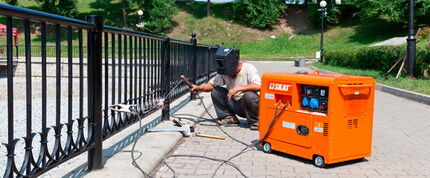
Inverters are economical and operate from a household network. In addition, it is better for a beginner to work with them. They are extremely easy to use and provide a stable arc.
The disadvantages of inverters include higher cost than other devices, sensitivity to dust, moisture and power surges. When choosing an inverter for home welding, pay attention to the range of welding current values. The minimum value is 160-200 A.
Additional features of the equipment can make the job easier for a newbie.
Among these pleasant “bonuses” it is worth noting:
- Hot Start - which means an increase in the initial current supplied at the moment the welding arc is ignited. This makes it much easier to activate the arc.
- Anti-Stick — automatically reduces the welding current if the electrode rod is stuck. This makes it easier to pull off.
- Arc Force - increases the welding current if the electrode is brought to the workpiece too quickly. In this case, sticking does not occur.
In addition to any type of welding machine, you will need electrodes. It is best to select their brand using a special table, which indicates the type of material being welded.
You will also need a welding helmet. The best one is the one that goes on the head. Models that need to be held in the hand are extremely inconvenient.
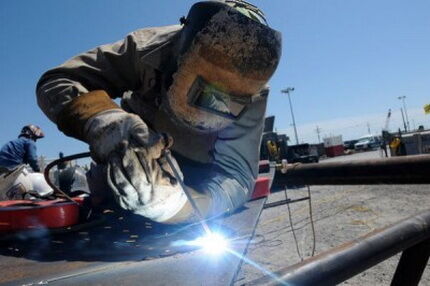
The mask may have a simple tinted glass or a so-called “chameleon”. The latter option is preferable, since when an arc appears, the glass automatically darkens.
It is necessary to work only in special clothing that protects from splashes and ultraviolet radiation. This could be thick cotton overalls, boots or high boots, canvas or rubberized gloves.
Article for you: 10 best masks for welders: review, photo, price. TOP 10 best welding electrodes.
Electric welding technology
It is better to learn how to properly weld parts using electric welding under the guidance of experienced welders. If for some reason this does not work out, you can try it yourself. First you need to properly organize your workplace. This is very important, since welding is a high-temperature and therefore fire-hazardous process.
To work, you need to choose a workbench or any other base made of non-flammable material. Wooden tables and similar products are strictly prohibited. It is advisable that there are no flammable objects near the place where welding will be carried out.
Be sure to place a bucket of water near you to eliminate possible fires. In addition, you need to determine a safe place where the remains of used electrodes will be stored. Even the smallest of them can cause a fire.
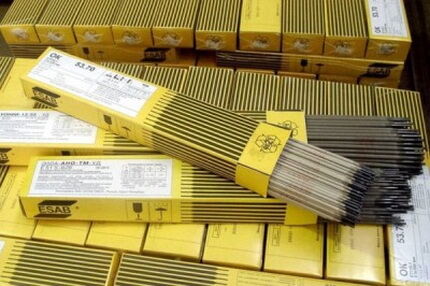
For the first independent seams, you need to prepare an unnecessary piece of metal and select electrodes for it. Experts recommend using 3 mm rods in such cases. The smaller diameter is used for welding thin sheets, which are inconvenient to learn from. Larger diameter electrodes require high power equipment.
We start by stripping the area of metal where the seam will be located. There should be no rust or any contamination.
After the part is prepared, take the electrode and insert it into the clamp of the welding machine. Then we take the “grounding” clamp and firmly attach it to the part. Let's check the cable again. It should be tucked into the holder and well insulated.
Now you need to select the operating current power for the welding machine. It is selected according to the diameter of the electrode. We set the selected power on the panel of the welding equipment.
The next step is igniting the arc. To do this, you need to bring the electrode to the part at an angle of about 60° and very slowly move it along the base. Sparks should appear. As soon as this happens, lightly touch the part with the electrode and immediately raise it to a height of no more than 5 mm.

At this moment, an arc flashes, which must be maintained throughout the entire operation. Its length should be 3-5 mm. This is the distance between the end of the electrode and the workpiece.
When maintaining the arc in working condition, you need to remember that during operation the electrode burns out and becomes shorter. If the electrode gets too close to the workpiece, sticking may occur. In this case, you need to slightly swing it to the side. The arc may not ignite the first time. Perhaps there is not enough current, then it needs to be increased.
After the novice welder has learned to ignite the arc and keep it in working condition, you can begin to weld the bead. This is the simplest of all operations.We light the arc and begin to very smoothly and carefully move the electrode along the future seam.
At the same time, we perform oscillatory movements resembling a crescent with a small amplitude. We seem to be “raking” the molten metal towards the center of the arc. This way you should get an even seam that looks like a roller. There will be small wave-like metal sagging on it. After the seam has cooled, you need to knock the scale into it.
Arc welding techniques - welding methods
To get a high-quality seam, you need to learn how to maintain and then move the arc. The length of the electric arc especially affects the quality. If it is more than 5 mm, then it is considered long.
In this case, nitriding and oxidation of the molten metal occurs. It splashes out in drops, making the seam porous and not strong enough. If the arc is too short, lack of penetration may occur.

Various techniques are used to perform welding. Let's look at the main ones in detail.
Option #1: Bottom Butt Joints
The most common and simplest way to connect parts. For metal thicknesses up to 0.8 cm, double-sided welding is used. For connections made of metal thinner than 0.4 cm, only one-sided welding is performed.
For work, electrodes are selected whose diameter is equal to the thickness of the metal. If it exceeds 8 mm, welding is carried out with cutting edges. In this case, the cutting angle is about 30°.
Welding is performed in several passes. It is advisable to use removable pads made of steel or copper to avoid burns. The first pass is performed with a small diameter electrode, no more than 4 mm.
When making the first seam, its accuracy and penetration depth are very important. After applying it, there should be no fused metal behind the edges.
For the second and all subsequent passes, larger diameter electrode rods are used. They are chosen for high-quality filling of the recess formed between the edges.
The electrode is slowly moved along the seam, performing oscillatory movements, as if rocking the electrode from side to side, in order to completely fill the voids with molten metal.
Option #2: Bottom Corner Joints
Experienced welders claim that good results can be achieved by welding corners “in a boat”. This means that the parts to be connected are installed at an angle of 45° or other.
This ensures the highest quality penetration of the product walls, and the danger of undercutting and lack of penetration is reduced. This welding method allows welding of large cross-section seams to be deposited in one pass.
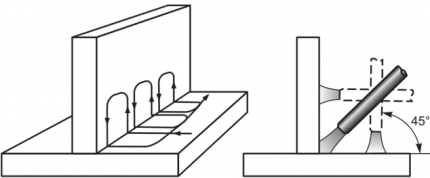
There are two types of boat welding - symmetrical and asymmetrical:
- The inclination of the parts is 45°. The likelihood of sagging or undercutting one of the walls is minimal. Welding of reverse and direct polarity is carried out at maximum current values. When carrying out reverse polarity welding, the length of the electric arc should be minimal.
- Tilt of parts at an angle of 60° or 30° - asymmetrical “boat”. This option is very convenient if work is carried out in hard-to-reach places, since the amplitude of movement of the electrode is small. The welder directs the arc to the very root of the seam, and care must be taken that it does not go beyond the boundaries of the future seam. It is also not allowed to deposit too much metal in one pass.
Corner joints can be T-type, so you need to learn how to weld metal correctly and without errors using electric welding in several passes.
The use of one pass is only possible when welding simple structures with sides that form an angle of 45° in a fillet weld. The diameter of the electrode in this case cannot exceed the thickness of the metal by more than 0.15-0.3 cm.
Standard multi-pass T welding is performed as follows. For the first pass, an electrode with a larger diameter is taken than those selected for subsequent passes.For example, an electrode is used whose dimensions vary from 0.4 to 0.6 cm.
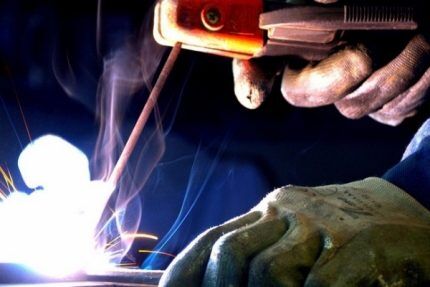
Welding is carried out smoothly, without transverse oscillatory movements. When performing other passes, they are necessarily carried out. It is important that the vibration amplitude is within the permissible seam width.
Another significant point. When performing T-welding on a fillet joint, the electric arc should always be ignited on a shelf positioned horizontally.
When doing electric welding of corners with your own hands, you can use an overlap type of connection. In this case, the parts to be welded are placed one on top of the other with an overlap. The arc during direct polarity welding should be short, and during reverse polarity welding it should be as short as possible. Direct the arc exactly to the root of the connection.
During the welding process, it is necessary to perform small amplitude reciprocating movements with the electrode. This will allow the entire joint area to be heated evenly. In this case, the weld pool will be evenly filled, and the seam will be convex and full-sized.
Option #3: vertical seams
Seams directed vertically are made only with a short arc. In this case, the working current should be 10% -20% less than when welding parts in the lower position. These requirements are easy to explain.
A lower current strength means that the molten liquid metal will not drain from the weld pool. A smaller arc is more convenient to use.
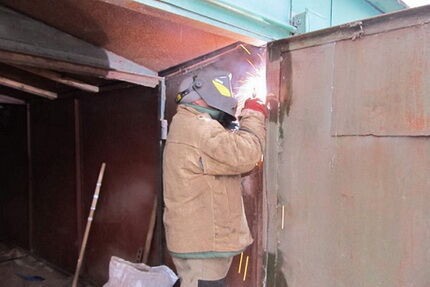
Experienced welders prefer to weld vertical seams from the bottom up. The arc is set on fire at the lowest point of the future seam. After that, a small horizontal platform is prepared, the dimensions of which correspond to the cross-section of the future seam.
Then slowly move the electrode rod up. In this case, movements across the connection must be performed.
They can be in the form of a herringbone, corner or crescent. The last option is the easiest to implement. In addition, it is important to maintain the correct position of the electrode. Theoretically, penetration is best achieved if the rod is positioned perpendicular to the seam, that is, horizontally.
Butt welds are characterized by the following criteria:
Practice shows that in this position of the electrode rod, liquid metal flows down the seam. To avoid this, the angle of inclination of the rod is chosen within the range of 45°-50°. This is the optimal option for vertical welding. To weld parts in the bottom-up direction, select electrodes whose diameter does not exceed 0.4 cm.
Option #4: Pipeline Details
At home, you often have to remember how to electric weld a metal pipe. A vertical seam is usually made on the side of the part, and a horizontal seam along the circumference. Steel pipes butt welded. All edges must be well boiled.
To ensure that the sagging inside the pipe is minimal, the electrode is brought to the product at an angle of no more than 45°. The seam width should be 0.6-0.8 cm, height – 0.2-0.3 cm.
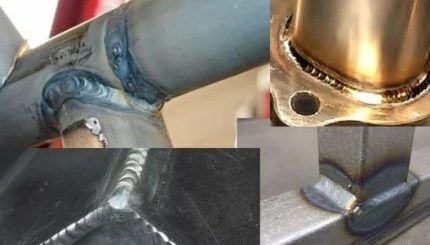
Before starting welding work, the parts to be joined are thoroughly cleaned. The ends of the pipe are inspected. If they are deformed, they are straightened or cut using a pipe cutter. Then the edges of the parts are cleaned from the inside and outside to a metallic shine at a distance of at least 1 cm from the edge. Then start welding.
The joint is welded without interruption until it is completely welded. For non-rotating joints of pipes with walls up to 0.6 mm wide, two welding passes are performed, for products with walls from 0.6 to 1.2 cm wide - three passes, for parts with walls wider than 1.9 cm - four passes.
In this case, each subsequent seam is applied only after the scale has been removed from the previous one.
The quality of the first seam is most important.During the process, all blunts and edges should completely melt. There should be no cracks, even the smallest ones. If they exist, they are smelted or cut down. After which the fragment is welded again. Welding of rotary pipes is performed in the same way.
Possible defects in welding joints and seams
Electric welding is a complex process and not always everything goes smoothly.
As a result of operational errors, seams and joints may have various defects, including:
- Craters. Small depressions in the weld bead. They may appear as a result of a broken arc or an error in the execution of the final fragment of the seam.
- Pores. The welding seam becomes porous as a result of contamination of the edges of the parts with rust, oil, etc. In addition, porosity can appear when the seam is cooled too quickly, at high welding speeds and when working with undried electrodes.
- Undercuts. They look like small indentations on both sides of the suture bead. Appear when the electrodes are displaced in the direction of the vertical wall when welding corner joints. In addition, undercuts occur when working with a long arc or when the welding current is too high.
- Slag inclusions. There are pieces of slag inside the welding bead. This can happen if the edges are dirty, the welding speed is high or the welding current is too low.
These are the most common weld defects, but there may be others.
Additional information on welding vertical and horizontal seams using electric welding is presented in this article.
Conclusions and useful video on the topic
Features of pipe welding:
How to choose the right welding inverter:
If desired, any home craftsman can master the basics of welding. It is not so difficult. It will require patience, accuracy and, of course, precise execution of all instructions. Everything will be much easier if the process of mastering a new skill takes place under the guidance of an experienced specialist.
Do you have personal experience connecting parts using electric welding? Do you want to share your accumulated knowledge or ask questions on the topic? Please leave comments and participate in discussions - the feedback form is located below.




Thank you! I learned a lot of useful things for myself. How to properly weld square pipes at an angle of 90?
A useful video, in my opinion, especially for delitians.
Thank you! It was very interesting to read.
thanks for the info
Good afternoon Sorry for asking without any outside representation, but there are no options…. Please answer the question. In welding work and concepts - complete zero. But the time is such that you have to take on everything. There was a need to weld thin (1 - 2 mm) ferrous metal. The donated Italian miracle Deca STARFLUX 130AC has been lying around for a long time. Output to the flux-cored wire directly from the transformer... Is this normal? How should they work correctly? Thank you….